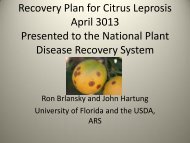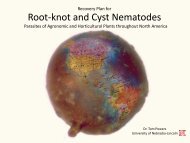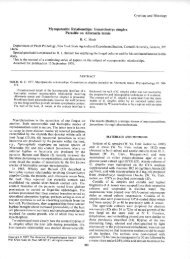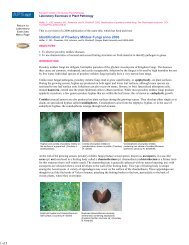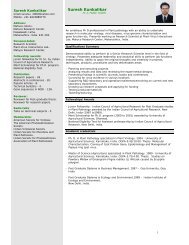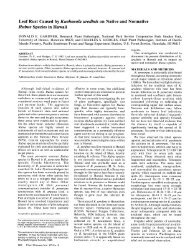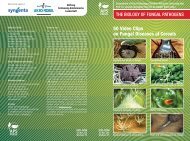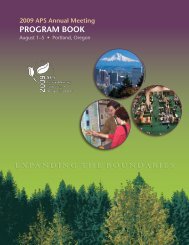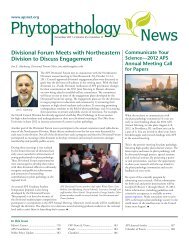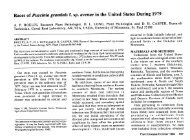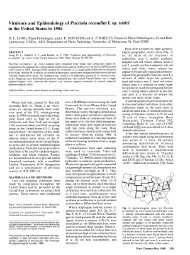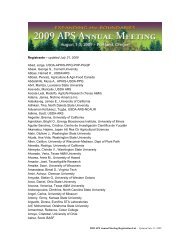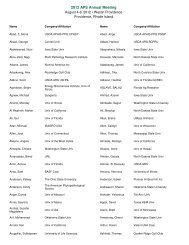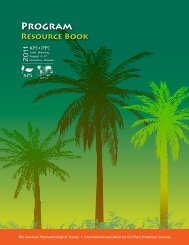view article - American Phytopathological Society
view article - American Phytopathological Society
view article - American Phytopathological Society
Create successful ePaper yourself
Turn your PDF publications into a flip-book with our unique Google optimized e-Paper software.
The relationship of populations of M. phaseolina and A. Karr. Department of Plant Pathology, University of Missouri, Columbis,<br />
microsclerotia (ms) in root tissue to final yield was deter- MO 65211.<br />
mined for the soybean cvs., Davis and Lloyd, grown under This study reports development of a rapid, sensitive, toxin bioassay with<br />
various irrigation regimes. Irrigation treatments included: E. coli and a selection by bioasssays with root cap, cotyledonary and leaf<br />
none, full-season, until flowering, and after flowering, cells and whole soybean plants for identification of resistant genotypes<br />
Biweekly, ma populations were determined in all roots to Macrophomina phaseolina toxin. Toxin is located by measuring the ability<br />
collected in a randomly selected 0.61 m section of row (my. of fractions to inhibit growth of E. coli, strain HB101, in soft agar<br />
12 plants/section). Recovery of ms began as early as 4 overlays. The samples to be tested [5 ul aliquots] in 95% (v/v) ethanol<br />
weeks after planting. Final soybean yields were positively are applied to the surface of the overlay, where toxic fractions cause a<br />
correlated (P=O.01) with irrigation and negatively corre- concentration dependent formation of clear plaques in the bacterial lawn.<br />
lated (P=0.01) with populations of ma from root tissue at For genotype selection, toxin-treated root cap, cotyledonary, or leaf cells<br />
weeks 16 (R4, pod development) and 18 (R5, early seed are tested for viability with Evans blue dye. Whole plants are scored for<br />
development). Microsclerotia were negatively correlated symptoms of leaf tissue collapse. With these techniques, the soybean<br />
with irrigation regimes (P0.01). There were no cultivar cultivars Chamberlain, Stine 3790, Resnik, Asgrow 4393 and Williams 82<br />
differences in populations of ma or yield. respectively, were ranked [least sensitive to most sensitive] in their<br />
sensitivity to the M. phaseolina toxin. Identification of the toxin raises<br />
the possibility for development of a selection program for resistance to<br />
356 charcoal rot.<br />
EFFECT OF RUST ON FORAGE YIELD AND DIGESTIBILITY OF DWARF AND<br />
TALL PEARL MILLET CULTIVARS. J.P. Wilson, R.N. Gates, and W.W.<br />
Hanna, USDA-ARS, Coastal Plain Expt. Stn., Tifton, GA, 31793. 360<br />
Effects of infection by Puccinia substriata var. indica on EFFECT OF CITRUS ROOTSTOCK ON POPULATIONS OF PHYTOPHTHORA<br />
yield and digestibility of pearl millet forage were examined PARASITICA IN FLORIDA. J. P. Agostini,* L. W. Timmer,**<br />
in 1988. Dwarf hybrids, Tifleaf 1 (susc) and Tifleaf 2 (res), W. S. Castle,** and D. J. Mitchell.* *Plant Pathology Dept.,<br />
and tall hybrids, Gahi 3 (susc) and Gahi 4 (res) were treated Univ. of Florida, Gainesville, FL 32611; **Citrus Research and<br />
with chlorothalonil or inoculated after the first harvest to Education Center, 700 Expt. Station Rd., Lake Alfred, FL 31<br />
establish different levels of disease. No differences in yield The effect of rootstock on the population of P. parasitica was<br />
or digestibility were detected between disease-free plots of determined by plating soil from the root zone-from two Valencia<br />
susceptible and resistant cultivars for either dwarf or tall sweet orange rootstock trials and one pot test with seedlings<br />
types. Rust severities of inoculated plots of Gahi 3 were 54% on selective media periodically from Dec. 1987 to Feb. 1989.<br />
of those of Tifleaf 1. Green yield, dry matter yield, and in The average number of propagules per cm of soil over 4 to 5<br />
vitro digestibility were negatively correlated with final sampling dates was: (St. Cloud, Avon Park, and pot test):<br />
disease severity and area under the disease progress curve of Palestine sweet lime (29,10,...), C. volkameriana (30,... ,.<br />
both cultivars. Dry matter concentration was unaffected by Ridge Pineapple sweet orange (... ,13,102), Cleopatra mandarin<br />
disease. Digestible dry matter yield (Y, percent of healthy (17,10,87), trifoliate orange (14,8,14), and Swingle citrumelo<br />
control) as a function of percent disease severity 10 days (4,5,14). Populations were significantly higher in the sYmmer<br />
before harvest (X), could be expressed as Y=97.6-0.75X, and (32 propagules/cm 3 ) than in the winter (3.4 propagules/cm ) due<br />
Y=01.6-1.O1X for dwarf and tall cultivars, respectively, to the greater root biomass in summer. Soil populations<br />
generally reflected the susceptibility of the rootstocks to<br />
P. parasitica with the lowest population on trifoliate orange<br />
and Swingle citrumelo and the highest on sweet orange.<br />
357<br />
A POSSIBLE TOBAMOVIRUS ASSOCIATED WITH RINGSPOT AND OAKLEAF<br />
PATTERN IN EPIMEDIUM X YOUNGIANUM CV. NIVEUIM. M. L. Putnam and 361<br />
S. T. Nameth. Maryland Dept. of Agriculture, Annapolis, MD EFFECT OF TEMPERATURE ON DISEASE SEVERITY OF CORKY ROOT OF<br />
21401 and Dept. of Plant Path., The Ohio State Univ., Ohio Agr. TOMATO CAUSED BY PYR.ENOCHAETA LYCOPERSICI. N. Shishkoff,<br />
Res. and Dev. Center, Columbus, OH 43210. USDA-ARS, Frederick, MD 21701 and R. N. Campbell, Dept. Plant<br />
Pathology, Univ. Calif., Davis, CA 95616<br />
Sap extracts from Epimedium leaves taken from a nursery in<br />
Maryland, showing chlorotic ringspots and oak leaf patterns were Tomatoes were sown in infested soil in microplots at monthly<br />
rub inoculated onto the leaves of indicator hosts. Symptoms on intervals from Feb. to May 1988 to provide varying temperature<br />
indicator hosts included local lesions on the inoculated leaves regimes. The disease progress curves were linear and<br />
of Nicotiana tabaccum cv. Samsun and Gomphrena globosa and a significantly lower only for the last planting date. Disease<br />
systemic infection and eventual death of Nicotiana benthamiana. severity was greater at 16 or 21 C than at 27 C when tests<br />
Chenopodium quinoa did not react. Sap extracts from infected were done in infested vermiculite in controlled environment<br />
'Samsun' leaves tested negative for TV (common strain), TSWV, chambers. In other experiments seedlings were grown in<br />
TSRV and TomRSV using an indirect-sandwich ELISA but positive infested vermiculite at 16 or 27 C and switched to sterile<br />
for viral-associated dsRNA. Electrophoresis of dsRNA in vermiculite and grown at 16 or 27 C for a lesion development<br />
infected 'Samsun' extracts revealed the presence of a replica- period. Disease was more severe at 16 C than at 27 C for the<br />
tive form of dsRNA with an estimated molecular weight of 4.2 x lesion development period, regardless of the infection<br />
106 and 4 subgenomic dsRNA's with molecular weights ranging from temperature.<br />
2.3 - 0.4 x 106. This appears to be the first report of virus<br />
associated with Epimedium.<br />
358<br />
PREDISPOSITION OF LATE EMERGING CORN PLANWTSTO EAR ROThING<br />
FUNGI. D. M. Huber, H. L. Warren, T. S. Roseman, and C. Y. Tsai. Botany & Plant<br />
Pathology Dept., Purdue University, W. Lafayette, IN 47907.<br />
362<br />
PATHOGENICITY OF ISOLATES OP RHIZOCTONIA SOLAIII AG-3 COLLECTED<br />
FROM POTATO PLANTS AND SOIL. D.E. Carling and R.H. Leiner.<br />
University of Alaska, 533 E. Fireweed, Palmer, AK 99645.<br />
Sclerotial, hymenial and lesion isolates of Rhizoctonia solani<br />
The effect of delayed emergence on growth, yield, and disease of four maize<br />
hybrids (A632xLH39, Pioneer Brand 3165, B73xMo17, and Callahan Brand C773)<br />
was evaluated under high fertility conditions on a Brookston silt loam soil.<br />
Treatments consisted of all plants emerging uniformly early, uniformyly 0days<br />
late, or a continuous mix of two early and one plant 10 days late. Final plant<br />
populations were 52,000/ha. No differences in growth, barrenness, biomass, or<br />
yield were observed for uniformly early, uniformly late, or early emerging plants<br />
in the mixed emergence treatments. Delayed emerging plants, adjacent to early<br />
emerging plants in the row, were severely stunted, excessively barren (70-90%),<br />
and produced only 20-40% of the biomass and 2-10% of the grain yield of early<br />
emerging plants. Ear rotting fungi were assayed by plating kernels on PDA and<br />
incubating at room temperature. Delayed emerging plants had 40-100% more<br />
kernels infected with Fusarium moniliforme, F. roseum, and Colletotrichumgraminicola<br />
than early or late uniform emerging plants,<br />
were collected from 20 plants from each of three fields in<br />
southcentral Alaska. Also, isolates were collected from soil,<br />
directly from pegs placed on KHP media, and indirectly via beet<br />
seed baiting. Additionally, isolates were collected (directly)<br />
from soils associated with several crops other than potato. All<br />
isolates were characterized as to anastomosis group (AG). Path-<br />
ogenicity testing was done on all isolates of AG-3 in soil on<br />
developing sprouts at 50 F. Nearly 95% of sclerotial, hymenial<br />
and lesion isolates but only 52% of soil isolates belonged to<br />
AG-3. Most isolates of AG-3 were moderately to highly patho-<br />
genic on potato sprouts. Pathogenicities of isolates collected<br />
from lesions, sclerotia, hymenia and soil were the same, P =<br />
0.05. Pachogenicicies of isolates collected from soils associ-<br />
aced with potato, carrot, barley, bluegrass or fallow were the<br />
same, P = 0.05. These data suggest that source and associated<br />
plant are not indicative of pachogenicicy of K. solani AG-3.<br />
359 363<br />
DEVELOPMENT OF BIOASSAYS FOR IDENTIFICATION OF SOYBEAN GENOTYPES RESISTANT INFLUENCE OF INOCULUM LEVEL AND IRRIGATION ON PHYTOPHTHORA ROOT<br />
TO MACROPHOMINA PHASEOLINA. F. Beleid-El Moshaty, A. Novacky, T.D. Wyllie, ROT OF PROCESSING TOMATO. 0. A. Neher and J. N. Duniway.<br />
1180 PHYTOPATHOLOGY



